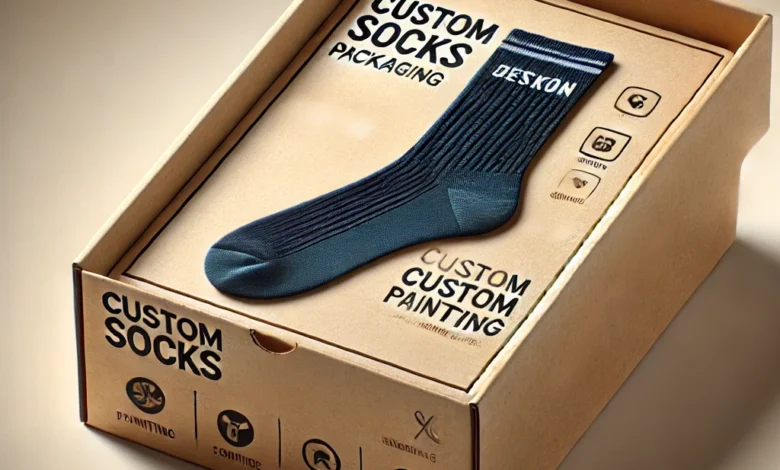How to Choose the Right Materials for Custom Socks Packaging Boxes | Comprehensive Guide
### Subtitle: Maximize Protection, Branding, and Sustainability with the Right Packaging Materials
- Learn about the benefits of cardboard, corrugated cardboard, kraft paper, rigid boxes, and plastic. Ensure product protection, enhance brand appeal, and opt for eco-friendly options.
How to Choose the Right Materials for Your Custom Socks Packaging Boxes: A Comprehensive Guide
Selecting the right materials for your custom socks packaging boxes is a critical decision that affects both the functionality and presentation of your product. High-quality packaging materials ensure the protection of your socks during transportation and storage while enhancing their visual appeal and supporting your brand image. This guide will help you navigate the various options and considerations for choosing the best materials for your custom socks packaging.
Understanding the Importance of Material Selection
The material you choose for your socks packaging boxes can significantly influence customer perception and product success. Key considerations include:
- Protection: The primary function of packaging is to safeguard the product from damage.
- Branding: Packaging serves as a tangible representation of your brand and can influence customer perception.
- Sustainability: Eco-friendly packaging options can appeal to environmentally conscious consumers.
- Cost: The choice of material impacts the overall cost of packaging and your profit margins.
Types of Materials for Socks Packaging Boxes
Here are some of the most popular materials used for custom socks boxes:
- Cardboard
- Advantages: Lightweight, cost-effective, and versatile. Ideal for custom printed socks boxes.
- Uses: Great for sock sleeve packaging and sock wrapping.
- Sustainability: Recyclable and often made from recycled materials.
- Corrugated Cardboard
- Advantages: Provides extra protection with its fluted layer. Durable and sturdy.
- Uses: Suitable for wholesale socks boxes and shipping packaging.
- Sustainability: Often recyclable and can be made from recycled materials.
- Kraft Paper
- Advantages: Eco-friendly and natural look. Strong and tear-resistant.
- Uses: Excellent for eco-friendly socks packaging.
- Sustainability: 100% recyclable and biodegradable.
- Rigid Boxes
- Advantages: Luxurious and high-end appearance. Very durable.
- Uses: Perfect for premium socks packaging and gift boxes.
- Sustainability: Typically reusable, though not always recyclable.
- Plastic
- Advantages: Clear visibility and water-resistant.
- Uses: Common in retail packaging for visibility.
- Sustainability: Generally not eco-friendly, but recyclable options are available.
Factors to Consider When Choosing Packaging Materials
When selecting the material for your custom socks packaging boxes, consider the following factors:
1. Product Protection
Your packaging should provide adequate protection to keep the socks safe from damage, moisture, and dust. If your socks are delicate or high-value, such as designer socks, consider using more durable materials like rigid boxes or corrugated cardboard.
2. Brand Representation
The packaging material should align with your brand’s identity. For instance, luxury socks might benefit from premium packaging materials like rigid boxes, while a more casual or eco-friendly brand might opt for kraft paper or recycled cardboard.
3. Environmental Impact
Eco-friendly packaging is becoming increasingly important to consumers. Materials like kraft paper and recycled cardboard are excellent choices for sustainable packaging for socks. Highlighting your commitment to the environment can enhance your brand’s reputation and appeal.
4. Cost-Effectiveness
While premium materials might offer better protection and a more luxurious look, they can also be more expensive. Balance your need for quality with your budget constraints. Cardboard and kraft paper are generally more affordable and still provide good protection and branding opportunities.
5. Customization and Printability
Consider how well the material can be customized and printed on. Custom printed socks boxes are an effective way to showcase your brand. Cardboard, kraft paper, and rigid boxes are all excellent for custom printing. Ensure that the material you choose can accommodate your design requirements.
Detailed Look at Popular Materials
Cardboard
Cardboard is one of the most versatile and widely used materials for socks packaging boxes. It is lightweight, affordable, and easy to customize with printing and finishing options. Cardboard is also environmentally friendly, as it is often made from recycled materials and is fully recyclable. This makes it a popular choice for eco-friendly socks packaging.
Pros:
- Cost-effective
- Lightweight
- Recyclable
- Excellent for printing and customization
Cons:
- Less durable than other materials
- May require additional reinforcement for heavy or high-value products
Corrugated Cardboard
Corrugated cardboard consists of a fluted layer sandwiched between two flat layers, providing extra strength and protection. This material is ideal for wholesale socks boxes and other packaging that requires higher durability. It offers good protection against impact and compression, making it suitable for shipping and storage.
Pros:
- Highly durable
- Provides excellent protection
- Recyclable and often made from recycled materials
Cons:
- Bulkier than standard cardboard
- Higher cost compared to regular cardboard
Kraft Paper
Kraft paper is renowned for its eco-friendliness and natural appearance. It is strong, tear-resistant, and can be recycled multiple times. Kraft paper is an excellent choice for brands that prioritize sustainability. It can be customized with printing and finishing to enhance its aesthetic appeal.
Pros:
- Eco-friendly and biodegradable
- Strong and tear-resistant
- Natural, rustic appearance
Cons:
- Limited color printing options compared to other materials
- Not as smooth or refined as some other packaging options
Rigid Boxes
Rigid boxes are made from thick paperboard, offering a luxurious and high-end packaging solution. They are extremely durable and can be customized with various finishes, such as embossing, foiling, and laminations. Rigid boxes are perfect for premium socks packaging and gift boxes.
Pros:
- Luxurious and high-end appearance
- Extremely durable
- Can be reused by consumers
Cons:
- More expensive than other materials
- Not always recyclable
Plastic
Plastic packaging offers excellent visibility, which can be beneficial for retail display. It is water-resistant and durable, making it suitable for environments where moisture could be an issue. However, plastic is less eco-friendly, though some recyclable options are available.
Pros:
- Clear visibility
- Water-resistant
- Durable
Cons:
- Less eco-friendly
- Can be more expensive depending on the type of plastic
Conclusion: Making the Right Choice
Selecting the right material for your custom socks boxes is a crucial decision that impacts product protection, brand image, and environmental footprint. By considering factors such as protection, branding, sustainability, cost, and customization, you can choose a material that best meets your needs and enhances your brand’s appeal.
Whether you prioritize eco-friendly materials, premium quality, or cost-effectiveness, understanding the pros and cons of each material will help you make an informed decision. As the market evolves and consumer preferences shift towards sustainability and high-quality packaging, staying informed about the latest materials and trends will ensure that your socks packaging continues to meet and exceed expectations.
FAQs About Choosing the Right Materials for Your Custom Socks Boxes
Q1: Why is choosing the right material important for custom socks boxes?
Choosing the right material ensures your socks are protected during transportation and storage, enhances their visual appeal, and supports your branding efforts. It can also impact your environmental footprint and cost-effectiveness, making it a crucial decision for both product safety and marketing.
Q2: What are the benefits of using eco-friendly materials for socks packaging?
Eco-friendly materials like kraft paper and recycled cardboard are sustainable, biodegradable, and recyclable. They appeal to environmentally conscious consumers, enhance your brand’s reputation, and contribute to reducing your overall environmental impact, aligning with the growing demand for sustainable packaging solutions.
Q3: How does the choice of material affect the cost of socks packaging?
The choice of material directly impacts the cost of socks packaging. While premium materials like rigid boxes are more expensive and offer luxurious appeal, more affordable options like cardboard and kraft paper provide good protection and customization potential without significantly increasing costs.
Q4: What materials are best for protecting high-value or delicate socks?
For high-value or delicate socks, durable materials like rigid boxes or corrugated cardboard are ideal. These materials provide superior protection against damage during transportation and storage, ensuring the socks remain in pristine condition and enhancing the overall perceived value of the product.
Q5: How can custom printed socks boxes enhance my brand?
Custom printed socks boxes allow you to showcase your brand through vibrant, high-quality prints and designs. This personalization helps differentiate your products, reinforce brand identity, and attract customers. Custom printing also enhances the unboxing experience, making it memorable and increasing customer satisfaction and loyalty.







